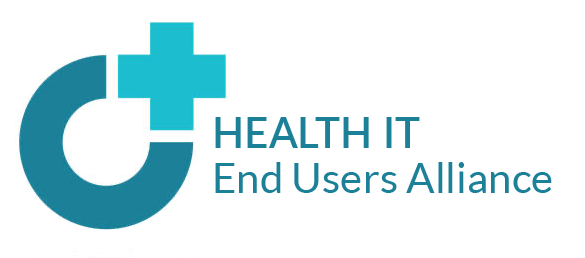
12 Sep Health IT End-Users Alliance
End-users of health information technology are coming together to form the Health IT End-Users Alliance, a group that will work to ensure that policy and standards development activities reflect the complex web of clinical and operational challenges facing those who use technology tools for care.
The Health IT End-Users Alliance will begin by putting forward consensus statements outlining the principles that must inform policy and standards development activities to address key pain points in the capture, use and sharing of health information. Critical topics include data governance, ensuring adequate real-world testing and implementation experience before adoption of standards and policies, and using data to address equity in healthcare.
Who We Are:
The Alliance brings together health information professionals, physicians, hospitals,and other front-line health care providers and organizations that use health IT in the provision of care.
Our Purpose:
To advance end-user perspectives in health IT policy and standards development, and to provide a collective voice to move beyond end-user involvement to end-user leadership. By working together, we can establish a set of priorities for how
technology should support clinical care and operations. These priorities can then be shared with standards developers, technology companies, and policy makers to shape their agendas and create better alignment.
Our Motivation:
Advancements in the use of information technology have improved clinical care and operations. At the same time, however, drivers other than provider and patient needs have been prominent in setting policy priorities and developing standards to
support technical solutions.
As we continue to increase reliance on technology to support clinical care, patient engagement, administrative transactions, and operational needs, it is more important than ever to ensure that end-user views inform health information technology policy priorities and standards development.
ISO states that standards answer the question “What’s the best way of doing this?”
End-user leadership can answer the preceding question: “The best way of doing what?”
The end-user perspective is needed to inform both standards development and policy. While standards organizations and technology companies do solicit end-user input into their processes, it can be challenging for those on the front lines to
participate, given the highly technical nature of the discussions and the focus on specific use cases. At a policy level, sharing the end-user perspective can create better alignment across the many regulatory requirements governing the use of
health IT.
Given competing objectives, and some of the challenges noted above, clinical and operational end-users have not always been sufficiently focused on developing and sharing their own objectives for how health IT can best support health care. A
commitment to greater engagement and collective work will help create a future state that is more aligned with end-user needs.
Frequently Asked Questions (FAQs)
Q: Is there a cost to participate in the alliance?
A: There is no cost to participate in the alliance.
Q: What are the benefits of participating the alliance?
A: Benefits include:
- – The opportunity to collaborate with other end-users to address key challenges
- – Regular updates from the alliance on relevant developments in standards and policy
- – Collaborative outreach to industry partners and policymakers on end-user needs and perspectives
Q: What are my responsibilities and opportunities for engagement?
A: Participants in the alliance agree to assist in the development of principles to inform policy and standards development activities to address key pain points in the capture, use and sharing of health information. (Each organization will have an
opportunity to consider each consensus statement. 100 percent approval from all alliance members will be considered final.) The alliance will hold virtual and in person meetings periodically and provide the opportunity for engagement with other stakeholders and policymakers to share perspectives.
For more information about the Health IT End-Users Alliance, please contact Lauren Riplinger, Vice President of Policy & Government Affairs, AHIMA at lauren.riplinger@ahima.org.
